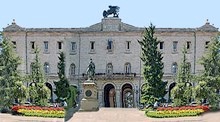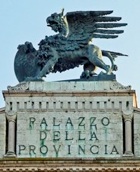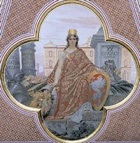


The new Palazzo del Governo (now the Palazzo della Provincia e Prefettura), which stood over what had been the central part of Rocca Paolina, was at the heart of the urban redevelopment of Perugia after the unification of Italy. A competition was held in 1863 in order to select its design. Local submissions included a joint proposal from Nazareno Biscarini and Americo Calderini that was well-received. However, the “outsider” Alessandro Arienti was appointed as civic architect in 1865 and his design for the palace was approved two years later. (Nazareno Biscarini and Americo Calderini published a critical report on this decision, but to no avail).
The palace is built on a rectangular plan that coincided with what had been the central part of Rocca Paolina. Its most distinctive feature is the loggia that runs around all four sides.

Sala del Consiglio
This room on the piano nobile has an octagonal plan and is lit from above by stained glass windows. The new Provincial Council met here for the first time in this room on 10th September, 1873.
Personifications of the Cities of the Province of Umbria (1873)
-
✴the cities of the Province of Umbria: Perugia (illustrated here); Foligno; Orvieto; Rieti; Terni;and Spoleto;
-
✴the Province of Umbria; and
-
✴the newly-united Italy
Stained Glass (1873)
Francesco Moretti designed and executed the eight stained glass windows. His preparatory designs also survive, in Casa Moretti-Caselli.
Sala dei Ricevimenti
Frescoes (ca. 1873)
This room on the piano nobile contains frescoes by Domenico Bruschi of famous Italians (mostly Perugians). They are split into six categories:
-
✴painters (including Perugino and Raphael);
-
✴architects (including Galeazzo Alessi);
-
✴soldiers (including: Braccio Fortebracci appearing humbly before Pope Martin V in Florence; and two scenes involving Biordo Michelotti: his receipt of a knighthood; and his murder);
-
✴goldsmiths and sculptors;
-
✴rhetoricians (including Bartolo Alfani di Sassoferrato being appointed as advisor to the Emperor Charles IV); and
-
✴men of letters (including Baldo Baldeschi with Galeazzo Visconti).
Sala degli Stemmi
This room on the piano nobile is named for the arms of the six cities of the Province, which were executed by Matteo Tassi.
Southern Gallery
Frescoes (ca. 1873)
The frescoes of the southern gallery are by Mariano Piervittori.


